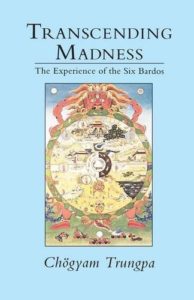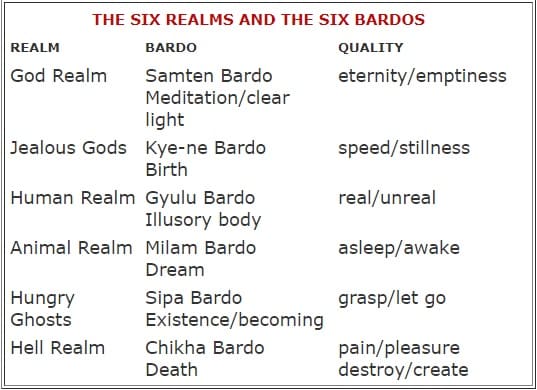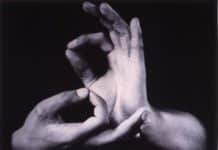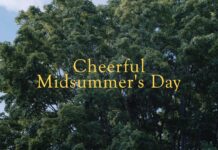THE SIX REALMS AND THE SIX BARDOS
The complete seminar entitled The Six States of Bardo Experience, given in Allenspark, CO July 15-24, 1971.
A book summary by Carolyn Gimian for the Chögyam Trungpa Legacy Project
Transcending Madness (abbreviated hereafter as TM) is based on two seminars given by the Vidyadhara Chögyam Trungpa Rinpoche (VCTR) in 1971, just a year after he arrived in the United States. During this period, he presented a great deal of Vajrayana material to public audiences, in an experiential context, which later his students realized was very advanced teaching.
The two seminars that make up the book are concerned with how the bardo states manifest in the everyday experience of practitioners and ordinary people in the world. In the first half of the book, VCTR looks at how bardo states and the six realms correspond, one on one. In the second half, he looks at how an individual cycles through all of the bardos while in a single realm. He is regarding the realms as psychological states experienced within the human realm.
In addition to the Varjayana understanding of this material, Trungpa Rinpoche was also presenting the material as an adjunct to working with students on developing a Buddhist approach to psychology and psychotherapy. The extremely direct experiential quality of the presentation at times seems to embody the realms and bardos it is describing. The editor of this volume, Judith Lief, writes in her foreword: “The Vidyadhara presented teachings on the realms and bardos as a way of understanding madness and sanity and learning to work directly and skillfully with extreme states of mind.”
The relationship of the bardos to death and dying is not particularly examined here but is discussed in other seminars he taught on The Tibetan Book of the Dead. (Much of that material appears in Trungpa Rinpoche’s commentary on the translation of the text.) When VCTR does touch in TM on the questions of reincarnation, karma and rebirth, he speaks of the problems with a simpleminded view, in which people feel they can make endless mistakes because they are coming back and can do better in the future. He says: “The present situation is important – that’s the whole point, the important point.”
The Six States of Bardo
The first half of Transcending Madness presents a seminar entitled “The Six States of Bardo.” Most of the seminar is concerned with the relationship of a particular realm to one of the six bardo states and the understanding of that experience.
In this seminar, CTR first defines bardo:
Bar means “in between” or it could be called “no-man’s land.”
Do is like a tower or an island in that no-man’s land.
CTR describes bardo as
- “present experience, the immediate experience of nowness – where you are, where you’re at. That is the basic idea of bardo.
- He also says: “All bardo experiences are situations in which we have emerged from the past and we have not yet formulated the future, but strangely enough, we happen to be somewhere. We are standing on some ground, which is very mysterious. Nobody knows how we happen to be there.”
- Finally, he expands the understanding of bardo: “That mysterious ground, which belongs to neither that nor this, is the actual experience of bardo. It is very closely associated with the practice of meditation. In fact, it is the meditation experience…It is also connected with the subject of basic ego and one’s experience of ego, including all sorts of journeys through the six realms of the world.”
The chart (from the appendix) showing the main topics discussed and how the bardos are related to the realms:

The Six States of Being
Transcripts from this seminar make up the second half of the book. Here VCTR says that bardo is:
that which is outstanding like an island in terms of your life situation, that which is between experiences…Bardo is that irritating and heavyhanded quality of pleasure just about to bring pain, invite pain. It is that kind of uncertainty between two situations.
CTR describes his overall approach to the seminar in this manner:
The concept of bardo has six types. It seems to be quite worthwhile to relate these six bardos with the six realms of existence…Each of these realms has some quality of extreme pleasure and extreme pain…but those extremes have entirely different textures in the various realms. For instance, there is the extreme hunger, rigidness and stupidity of the animal realm; the extreme indulgence of the human realm; the extreme relativity of the jealous gods realm. All kinds of realms take place, each with their bardo states.
What we are going to discuss is largely the psychological state where there is pain as well as pleasure – physical pain, psychological pain, or spiritual pain; spiritual pleasure, psychological pleasure, or physical pleasure. All six realms are characterized by this continual process of striving…The bardo experience tells you the details of the texture or the color or the temperature of godlike mentality or hell-like mentality; whatever it may be. It tells you in great detail about these basic situations or realms, about things as they are in terms of panoramic vision. (pages 184-185)
The following list (Appendix B) is how one cycles through the bardos within any realm.
Note that the inclusion of chonyi bardo (which VCTR says points to the fundamental shifty quality of experiences) increases the number to seven bardo states.
THE CYCLE OF THE BARDOS
Becoming/Sipa
Birth/Kye-ne
Dream/Milam
Death/Chikha
Isness/Chonyi
Meditation/Samten
Illusory Body/Gyulu
VCTR describes this cycles of bardos as follows:
- Sipa bardo, the bardo of existence or becoming, stems from the current situation being manipulated by extreme hope and fear. So the birth of each realm is given by sipa bardo.
- That birth brings another birth, or kye-ne bardo, which is associated with manifesting the becoming process further. Sipa bardo is more a force of energy. Kye-ne bardo is the energy materializing or functioning within a context.
- The continuity between birth and death, that which builds a bridge between birth and death is the struggle for survival or a maintenance process. This takes the form of a past-present-future dwelling process. Both the past and the future could be said to be imaginary worlds. That is milam bardo or dream bardo. It’s not literal dreaming but imagination. The dream bardo is going along hoping things will develop in accordance with your wishes. It is building a dream on your dreams.
- Chikha bardo is the death of your dreams; realizing that they are not all that realistic and that you are going to die. You feel the failure of continuing your existence.
- Experiencing the transitoriness and impermanence, you begin to question, which is where the chonyi bardo, or the bardo of dharmata, begins to develop. The bardo of dharmata is awareness of the basic space in which things function. It is spaciousness or lubrication. Chonyi is described as clear light, which is lubrication, accommodation, letting things follow their own course.
- This brings samten bardo, or the bardo of meditation. Having experienced the clear light or wisdom of chonyi bardo, samten bardo is the experience of wisdom becoming knowledge, jnana becoming prajna. The meditative experience of samten bardo is the microscope with which you could examine the clear light experience. It is not so much the practice of meditation as seeing things clearly, as they are.
- For example, in the hungry ghost realm, samten bardo is beginning to realize the sharp edges of hungry ghost experience, as well as the space in which the sharp edges could exist. This happens in any realm.
- Samten bardo is also described as a watcher that transmits a message to the observer. It is a super watcher. Here there are two types of intelligence: crude intelligence is the watcher, the analyst; subtle intelligence is the analysis transformed into experiential understanding.
- Finally, this leads to the bardo of the after-death experience, which is called gyulu bardo, or the bardo of illusion. We are suspended in the extreme experience of our life situation, whatever realm it may be. We realize that we are suspended: we haven’t really been born, we haven’t really died, we haven’t really been dreaming. We haven’t experienced or understood the clear light experience at all. All of those situations are expressions of suspension, being in the no-man’s land of bardo.
- This can allow us to relate with the realms not purely as suffering or as dwelling on something. In order to dwell, you have to play games with the occupation, whatever it is. If you can realize the simplicity of a realm, the inevitability of it, in some sense, then you can relax.
- In the human realm, for example, you are born, you grow up, you have to have an occupation, you feed yourself, you grow old, you experience illness and death.
- Every realm is similar: you have birth, you have death, you have suspension between those two, you have dreams.
- Realizing this, you experience that your life consists of both space and objects, form and emptiness, simultaneously, side by side.
- CTR summarizes this way
-
We are putting that confusion into a pattern. Confused nature has a pattern. It is methodically chaotic. This seems to be a way of seeing those patterns as they are. It seems to be a necessity of learning that you begin to have a sense of geography, a road map of some kind, so that you can relate with such patterns. That brings more solidity and confidence. So you don’t have to look painfully for some kind of stepping stone; instead a stepping stone presents itself in your life. (296-297)
-
The Lonely Journey
Chapter Nine, “The Lonely Journey,” (pp 163-180) is a poignant summary of how this material applies to the practitioner’s journey:
- Everyone goes through phases of so-called normality and abnormality, such as tension, depression, happiness, and spirituality. Unless we are able to apply this material to everyday life, there is no point.
- The six types of bardo experience are present all the time. There is the domestic problem of the hungry ghosts, in terms of comfort, luxury, hunger and thirst; the competitive problem of the jealous gods, the asura level; the spiritual problem of the realm of the gods; etc. These realms are not other lands, not situations outside. They are within us: we have domestic problems, emotional problems, spiritual problems, relationship problems…
- Each of these problems has its exit or highlight. In each, there is the possibility of completely flipping out or of stepping out of the confusion. Each situation presents its highlight of this and that. This is bardo.
- This seminar is based on seeing the situation of sanity and insanity. It has to do not only with working with ourselves but working with other people.
- The path is a lonely, individual journey in which we cannot expect praise or acknowledgment. VCTR speaks of his own experience with Jamgon Kongtrul and of Gampopa’s experience: being late to see his teacher, and finding that Milarepa had died.
- The Vidaydhara also discusses how he and his students are working on the karmic pattern of America. “The magical powers of materialism and spirituality are waging war.” This is a dangerous situation because there will be physical and psychological attacks. We are working on the infiltration of the materialistic world. Meditation is the technique of infiltration or the transmutation of negative hostile forces into positive creative situations.
© 2008 Carolyn Rose Gimian for the Chögyam Trungpa Legacy Project
Readers’ Comments
VCTR Teachings on Bardo
Hello
I have been listening to VCTR teachings on Bardo, and am so deeply impressed by these teachings and wondering if there is a way I can download mp3 to be able to listen on my ipod whenever able? I would make additional donations in support of the archives or purchase if possible
Thank you
Andrea Pucci
Remembering Guru, Teachings, Sangha
Thank you so much for making this form of these teachings available. I’ve been listening to these tapes as well are reading the book Transcending Madness. The two together of tapes and book are very helpful. As a student of the Vidyadhara from the seventies I just cannot get enough of my master’s voice.
I also attended the program this weekend with Dzongsar Khyentse Rinpoche. He certainly helped deepen my understanding of this. Inspired as he said by the approach and profundity of Chogyam Trungpa Rinpoche’s teachings, Dzongsar Rinpoche was also adroit at presenting a multi-layered and multi-faceted teachings that benefited both young and old, both new and seasoned practitioners. Here is how to understand as well as how to practice. Here is how to apply this to our daily lives as well as to the greater transitions of life and death and beyond. Far out! But “don’t freak out,” as Trungpa Rinpoche taught in the 1970’s as how to experience awakened wisdom.
When this program of Dzongsar Rinpoche is available at his web site, could you please post a precise link? And please turn up the volume on the voice of Trungpa Rinpoche. The introduction has good volume, but when the master starts to speak the volume is so low that it is difficult to hear. Even when I do all I can at this end to turn it up.
Supplicating my Guru,
David Wimberly
Allen’s Park summer 1971
I hitch-hiked up to Rinpoche’s house in Four Mile Canyon in early July1971 to catch a ride up to the first summer seminar in Allen’s Parkalong the Continental Divide. I got a ride in the back of a truckdelivering supplies with, among others, a tall colorful talkativefellow named Alan Marlowe who said he had just returned from Thailandwhere he had been practicing in a monastery as a Buddhist monk.
I have many vivid memories of those 10 days which were extremelyformative in my 21-year-old life and emerging Buddhist path.Rinpoche’s teachings were utterly unfathomable and equallycaptivating. Marv Ross was taping the talks, and immediately aftereach teaching I would listen to them with his headphones to try andcomprehend what Rinpoche had just taught us. We also had discussiongroups in the afternoons. But I was still utterly bewildered by thematerial (even though I had studied Kant and Hegel as a philosophymajor at UCLA two years earlier).
Karma Dzong — with Jonathan Eric’s inheritance — was about topurchase the land near Red Feather Lakes which Rinpoche soonchristened Rocky Mountain Dharma Center (and Sakyong Mipham renamedShambhala Mountain Center many years later). The Pygmies were planningto move up there later in the summer, and I planned to move there,too. There was some discussion about me camping with them in themountains above Boulder until it was time to move up to “the land.”But one of the Pygmy guys said it wouldn’t work out because I was notdeferential enough to men.
The camp at Allen’s Park had some horse stables, and one afternoon Idecided to go riding. The horse bolted away up the mountain carryingme along with him. As we raced past Rinpoche’s cabin Lady Diana camerunning out and yelled at me “Kick him! Control your horse!” I managedto stay upright, but it was a wild ride. A foreshadowing of things to come…
Chris Keyser
Berkeley, Calif.






